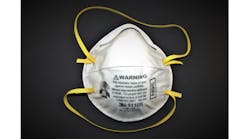The Occupational Safety and Health Administration (OSHA) has updated its Frequently Asked Questions (FAQs) regarding the use of N95 facemasks in the workplace with the intention of reducing the potential for workers of contracting the COVID-19 virus.
The agency also has addressed its standards regarding respirators and particle size, and at the same time it explained how N95 respirators effectively protect wearers from coronavirus exposure given rumors that they are not effective in blocking the virus.
Internet rumors have been circulating for a while now that assert the N95 masks do not protect wearers from COVID-19 transmission. The main reason given is that the fabric used blocks few, if any, of the smallest virus particles.
OSHA’s addition to its COVID-19 FAQs regarding respirators and particle size posits states: “Will an N95 respirator protect the wearer from the virus that causes COVID-19?” OSHA’s answer is that yes, an N95 respirator is in fact effective in protecting workers from the virus that causes COVID-19.
Throughout the pandemic, some have mistakenly argued that because the novel coronavirus that causes COVID-19 is around 0.1 microns in size, wearing an N95 respirator will not protect against such a small virus, note attorneys from the law firm of Seyfarth Shaw LLP.
According to OSHA, “that mistaken claim appears to result from a misunderstanding of how respirators work.” In fact, research has shown that the N95 respirator filter is very effective at protecting people from the virus causing COVID-19, the agency says.
The National Institute for Occupational Safety and Health (NIOSH) has conducted various tests and found that, due to the dynamics involved in filtration, an N95 respirator is actually “more effective at filtering particles that are smaller or larger than 0.3 microns in size,” OSHA points out.
One reason is that the virus particle is always attached to something larger which won’t pass through the mask, medical researchers say.
“When an infected person expels the virus into the air by activities like talking, coughing, or sneezing, the airborne particles are composed of more than just the virus,” OSHA explains. “The virus is part of larger particles that are made up of water and other materials such as mucus. These larger particles are easily trapped and filtered out by N95 respirators because they are too big to pass through the filter. This is called mechanical filtration.”
However, the agency adds, “Mechanical filtration is just one of the ways that respirator filters keep particles from passing through the filter. An electrostatic charge also attracts particles to fibers in the filter, where the particles become stuck. In addition, the smallest particles constantly move around (called Brownian motion), and are very likely to hit a filter fiber and stick to it.”
The Seyfarth Shaw attorneys also stress, “It is important for employers and workers to remember that a respirator only provides the expected protection when used correctly. Respirators, when required by an employer, must be used as part of a comprehensive, written respiratory protection program that meets the requirements of OSHA’s Respiratory Protection Standard.”
As part of such a program, they say that employees must be properly fit tested for the make, style and size of the N95 they will be using, must receive training on respirator use and maintenance, and must don and doff the respirator correctly.

